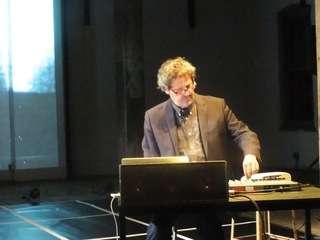|
Back
East Side, West Side... New York
The Invisible Dog
10/17/2019 - & October 18, 2019
Dan Siegler: Concrète Jungle
Dan Siegler (Audio Control), Pam Tanowitz (Dancer), Christina Campanella (Vocalist), Tomoko Omura (Violinist), Greg Chudzik (Bassist)
Robert Siegler (Photography), Davison Scandrett (Lighting Design), Dawn Sinkowski (Set and Video design)

D.Siegler at controls (© Samuel A. Dog)
“There is no place like it, no place with an atom of its glory, pride, and exultancy. It lays its hand upon a man’s bowels; he grows drunk with ecstasy; he grows young and full of glory, he feels that he can never die.”
Walt Whitman (1819-1892)
“It’ll be a great place, if they ever finish it.”
O. Henry (1862-1010)
Only a Manhattan-born eclectic avant-garde, jazz, dance-theater-concert composer like Dan Siegler would have the audacity–oh hell, the chutzpah–to invite an audience for a 45-minute recorded tapestry of Manhattan-bred noise, gossip, radio snippets, cussin’, ambient sounds, yadda-yadda-yadda, subway-chatter and the audible ephemera that we–supposedly–hear every day in New York.
That was Concrète Jungle, the recorded sounds of–supposedly, again–the sounds of Olde New York, with pictures by the composer’s father to match. Briefly, Mr. Siegler himself sat behind a console, and finagled the buttons to produce all the New York noise and clatter which, as the comic Lewis Black said, “takes away from all the noise and clatter going on in my own mind.”
In between, for reasons which escape me, a dancer came onto the large stage in the Brooklyn showplace, “The Invisible Dog”, and for a minute did some warm-up ballet exercises. A violinist came on stage and ran down a scale or two and scratched at the strings. Ditto for a bass player (one minute) and a vocalist who looped her own dulcet tones.
Yet these were flyspeck (to take a New York tenement adjective) diversions. Dan Siegler and photographer Robert Siegler were the stars of a tribute to a New York which the composer says has disappeared. In a program essay, he decries the disappearance of the old Times Square, graffiti and “countless bars and restaurants.”
That’s confusing. Okay, Giuliani disinfected Times Square (leaving corporate parasites and conglomerate vermin in its place). But graffiti is now commercial, bars and restaurants are booming, at least in my East Village.

D. Siegler and cast (© Samuel A.Dog)
Confusing too were the sounds and the pictures. This massive collage of sounds (the Concrète of our concrete jungle) sounded like a massive collage, not New York at all. It was supposed to be old New York, but we heard snippets about Woman’s Lib and our politics.
The rest, I’m afraid, didn’t sound like a real New York at all. It sounded like the Warner Brothers gangster movies of the 1930’s. Most of them written by journalists transplanted to Hollywood to give the Hicks and Yokels a fancified picture of New York. The mélange came out like the background of a James Cagney black-and-white, or, more likely, a Bowery Boys ersatz Gotham.
Robert Siegler’s black-and-white pictures, which were blacked or whitened out, showed a monochromatic New York. I was taken back, not to my childhood (which, granted, was in Yonkers) but to Shanghai in the 1960’s. Huge street-crowds, badly dressed masses, sombre, stolid.
That New York was not only unattractive, it was Third World, unattractive, a city so ugly that Mr. Siegler’s paean to a great city made no sense at all.
Musique concrète was fashionable enough in the late 1940’s and early 1950’s. It was one of the realizations of revolutionary inventions for sound, for distortion, for editing. Today, it is a good tool.
Mr. Siegler obviously went to a great deal of trouble making his Manhattan sounds, yet in the long run they have the romance of the homeless, the forgotten. Not the subway-riders, for whom talk is an ancient way to communicate by screens and pixels.
Perhaps unreasonably, I would have preferred the words, even interrelated, decomposed, confused, of Whitman and O. Henry, of the Cranes (Hart and Stephen), of Washington Irving, Lorenz Hart, Ira Gershwin and S. J. Perelman.
Not so unreasonably, I would have preferred point, structure (not classical or architectural but Mr. Siegler’s personal architecture. Not necessarily ideological, but with an idea behind its composition.
The sounds and pictures became a sad semblance of Times Square on New Year. Not so much diverse as amorphous. Not so much emotional or even entertaining as loud, empty and–contrary to New York itself–dreary.
Harry Rolnick
|